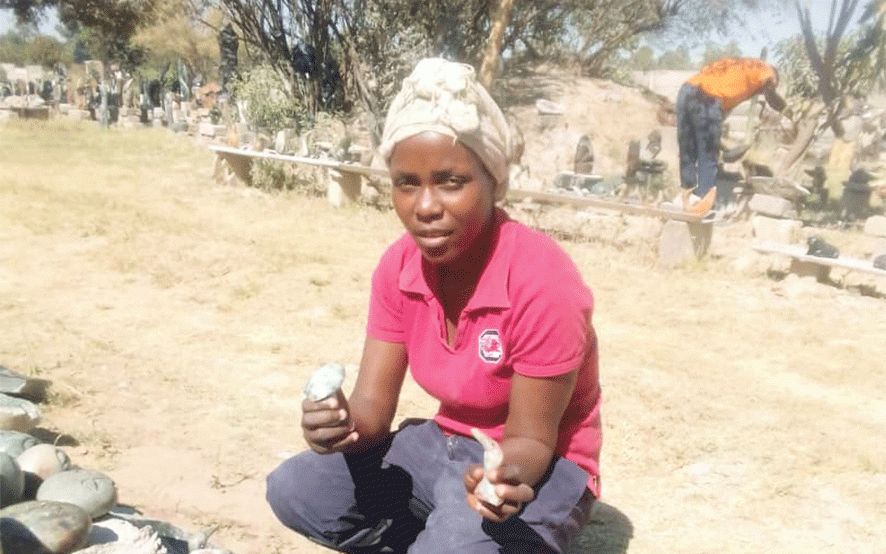
AWARD-WINNING stone chipper Dorcas Mutemasango attributes her creative proficiency to the good mentorship she received over the years from veteran artist Givemore Mashaya. Mutemasango also appreciates the gender reactive sentiments in Mashaya’s statutes like Welcome Mama and Singing Female Musicians, among others.
She said the artefacts inspired her to focus more on the values and roles of women in African societies.
Her award-winning Secrets of a Woman abstract fetched her several leads for carving male bald heads and mushrooms among other creative responses.
Most recently in pursuit of the current trends on tolerance for differentiated positions on beauty, Mutemasango unveiled various abstracts on female hairstyles which she said were an expression of Zimbabwe’s rich cultural diversity.
“It took me a long time to master the art of stone carving until I got help and close attention from veteran artist Mashaya who monitored me for close to two years,” she noted.
“About my carvings, The Way We Live is a reflection of our day-to-day living as beings from childhood to adult life. Hairstyles are an expression of diversity as well as a means to show women’s ability to take care of themselves and their freedom of expression.
“There are many hairstyles here, pony tales, braids, 100 lines, curly hair and doek, among others in verdite, opal, spring stone and cobalt.”
She continued: “Enjoying Territorial Strength and When the World Turns Around were my responses to the many challenges people faced during the COVID-19 pandemic. People had to innovate within their homes to feed their families and a co-ordinated response to the disaster would have been the only sustainable solution.”
- Chitown sculptor defies male dominance
- Lifeline for Chitungwiza Arts Centre
- Chitown sculptor defies male dominance
- Lifeline for Chitungwiza Arts Centre
Keep Reading
Mutemasango believes people’s bias towards information technologies worsened their hardships because too much marketing without means to deliver products in most cases spoiled the markets.
She, however, encouraged artists to make the best use of information technologies through tools which can enable sales and deliveries.
“We wish to have a more efficient marketing and selling platform for visual artists. Artists, however, must stick to their stone carving duties and perfect their works to the very best of their abilities,” she said.
Mutemasango’s garden at the Chitungwiza Arts Centre makes passersby pause in deep thought as each of her pieces needs an explanation in order to fully understand it.
After closely observing the growth stages of mushrooms, she came up with several carvings for what could be called mushroom morphology.
“A mushroom farmer must be very watchful of all growth stages from nursery to harvest stages. I therefore, came up with these carvings namely, germination, pests attacked and healthy growth,” she said. “Mushroom is nourishing food and that is why my friend here, Richard Mupumha aka Mushroom looks healthy because he has a regular intake of mushroom protein,” she said.
Mutemasango is one of the 12 female sculptors at the Chitungwiza Arts Centre who usually work at the ladies gazebo stand.
She is however, very nomadic migrating to some nearly 200 sculpture workshop stands to provide fine touches to details and smooth finishes to her works.
Mutemasango is very particular about not infringing copyrights by maintaining her strict sense of originality, which explains why she is arguably the most sought-after assistant during her free time.
“We face a lot of rivalry from our experienced male counterparts when it comes to sales and rewarding competitions. As such we are appealing for more equal opportunities for enhancing female artisanship,” she told NewsDay Life & Style.
“To a greater extent this explains why I am much more focused on women empowerment and raising general awareness on issues of concern.”
Mutemasango said she joined Chitungwiza Arts Centre after being inspired by how several male sculptors bought foodstuffs and clothes she had brought from South Africa.
“Sculpture works take too long to sell, but the end results are much more rewarding and that is the reason why they have been consistent in this trade for the past years,” she said.
“Visual art brings more realistic meaning to life and people should bring the artifacts into their homes for beauty and inspiration.”







